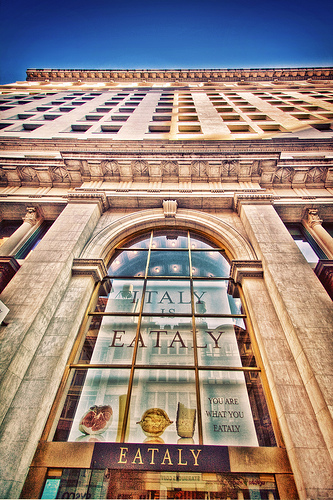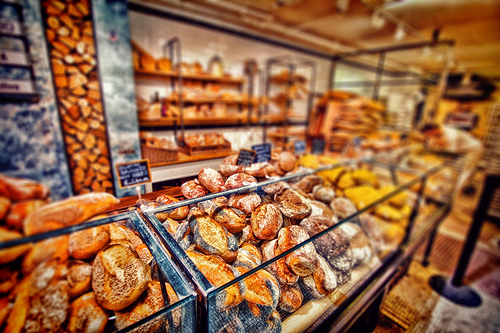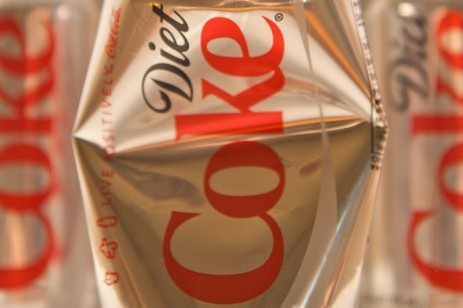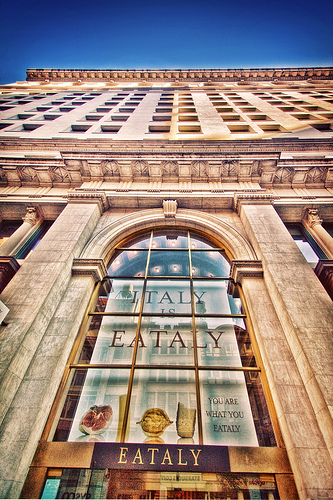 Eataly is nice, but there’s still plenty of room left to reinvent the supermarket.Photo: Samantha DeckerThe American supermarket experience hasn’t changed much in a half century. It’s basically a connect-the-dots problem each consumer solves differently: How do you get in, get the things on your list, avoid those annoying people with the slow-moving carts, and get out as swiftly as possible?
Eataly is nice, but there’s still plenty of room left to reinvent the supermarket.Photo: Samantha DeckerThe American supermarket experience hasn’t changed much in a half century. It’s basically a connect-the-dots problem each consumer solves differently: How do you get in, get the things on your list, avoid those annoying people with the slow-moving carts, and get out as swiftly as possible?
In the process of solving the puzzle, we all get to know the commercial topography of our chief foraging zones very well: dairy, meat, breakfast cereals, canned soups. But then this: We get to the end of our shopping list and discover a solitary item that’s been missed. This phenomenon is known, at least by me, as “The Caper Problem.” (Sometimes the “The Horseradish Problem” or “The Mini-Gherkin Problem.”) This fugitive item forces us to retrace our steps through aisles that suddenly seem unfamiliar, walking and scanning slowly in a slow-motion search.
When I first walked into Eataly New York — the 50,000-square-foot Italian-themed food market and dining experience that opened in midtown Manhattan late last August — my impression was that everyone was looking for the capers. They moved slowly. They stopped to marvel. No one knew where they should be heading, and apparently by design — the sprawling store feels like a series of little villages and outposts to be explored. Here, you roam the aisles of unpronounceable pastas. Over there, you elbow your way to a stand-up table in the enoteca. Everyone seemed relaxed and to be enjoying the experience. The sight of happy and slow-moving New Yorkers is a striking if slightly alarming spectacle.
Eataly is truly a marvel of social-commercial engineering. But it also struck me as a hugely missed opportunity.
I’d visited the original flagship Eataly in Torino, Italy, about a year after it opened in 2007. I stopped by mostly to be polite — an Italian friend had told me I should go. (“It’s Dean and DeLuca meets Whole Foods on steroids!” he said. “Whatever,” I thought.)
Then I ended up spending six hours and two meals there. Eataly — which Italians seemed to pronounce in a drawn out manner that pains them slightly — upended the very notion of how and where we shop for food. It was endlessly fascinating to me.
Like Eataly New York, Eataly Torino forced me to slow down at every step, with culinary areas neatly curated — meat here, seafood there, baked goods a little further along. It featured nine dining areas where you could buy meals prepared from foods sold a few yards away.
But Eataly Torino did something even more sly. Through a sort of clever alchemy, it converted the mundane experience of buying groceries into an educational experience. Eataly was a Trojan horse of a supermarket — a place that lured you in for shopping and dining, then educated you about local foods and the complex connections between producer and consumer.
That process starts early in Torino. Shoppers are faced with a large, reliquary-like display near the entrance, showing what’s currently in season. Nearby is a library and reference area with Apple computers rigged for exploring food culture; people were slumped down in chairs reading. Reading! In a supermarket! The slogan “Facciamoci Furbi!” was emblazoned nearby — which someone translated for me as “Be more clever!” Cloth shopping bags and shirts were for sale emblazoned with the Slow Foods logo.
And that logo was telling. Eataly Torino was founded by Oscar Farinetti, an entrepreneur who created the UniEuro chain of electronics, then sold it for a handsome profit. His longtime friend was Carlo Petrini, who founded the Slow Foods movement not far from Torino in 1989. Farinetti wanted to establish a shop that would support and build upon the concept of Slow Food, and the two worked together to do so.
The Slow Food movement is not just about speed, of course, but also about place. And Eataly Torino stuck me as a wonderful portal to local fare, with the great bulk of offerings sourced from the Piemontese region. The shop felt intimately connected with the city, with the hills on the horizon just beyond, with the region’s past. Eataly is even housed in an old vermouth factory, and on the top floor is an engaging museum that plumbs the Italian invention of vermouth, one of the nation’s many remarkable contributions to civilization. The shop’s mission statement claims that we “reach our objective when consumers understand that they are co-producers… therefore responsible not just for the quality of their own lives, but also the lives of those who produce food, the farmers, fishermen, bakers, cheesemakers and so on.”
 At least the bread is local.Photo: Samantha DeckerI admit I walked into the New York Eataly with high hopes after Torino. But once I slowed down and enjoyed the village sensibility, something seemed amiss. It was celebration of a place — but a place thousands of miles away, not this place. Esquire magazine proclaimed Eataly to be “a fever dream of food love — a fantasy, an orgy, a theme park” — and that theme park didn’t involve local food, but what the Wall Street Journal dubbed “Mario World,” after one of the partners behind it, star chef Mario Batali.
At least the bread is local.Photo: Samantha DeckerI admit I walked into the New York Eataly with high hopes after Torino. But once I slowed down and enjoyed the village sensibility, something seemed amiss. It was celebration of a place — but a place thousands of miles away, not this place. Esquire magazine proclaimed Eataly to be “a fever dream of food love — a fantasy, an orgy, a theme park” — and that theme park didn’t involve local food, but what the Wall Street Journal dubbed “Mario World,” after one of the partners behind it, star chef Mario Batali.
There’s Italian wine and beer and soda and imported pasta by the shelf. The Piemontese beef? I read that it originates from Italian cow embryos, which were flown to Montana and raised there, and then shipped back to New York. So it’s local food only if you count unborn cows changing planes at JFK. Even the wood-fired pizza ovens were brought in from Italy.
It’s not that the local is overlooked — Eataly carries produce grown on a rooftop garden in Queens, fish from local waters, and fresh-baked bread — but local here tends to feel like the “local” section that every chain supermarket feels obligated to install these days — a sort of begrudging nod to a trend. It’s not the driving force behind the store, as it is in Italy.
There’s still an opening here. I hope someone exports the idea that undergirds the original model of Eataly to our shores. Someone with vision and star power could combine education and a celebration of the local, can move the local farmer’s market to a bigger stage, can bring to the attention of a broader swath of consumers an understanding that they’re “responsible not just for the quality of their own lives, but also the lives of those who produce food.”
That is, of their neighbors.
My advice to entrepreneurs: Be More Clever. There’s plenty of room yet to reinvent the supermarket.




